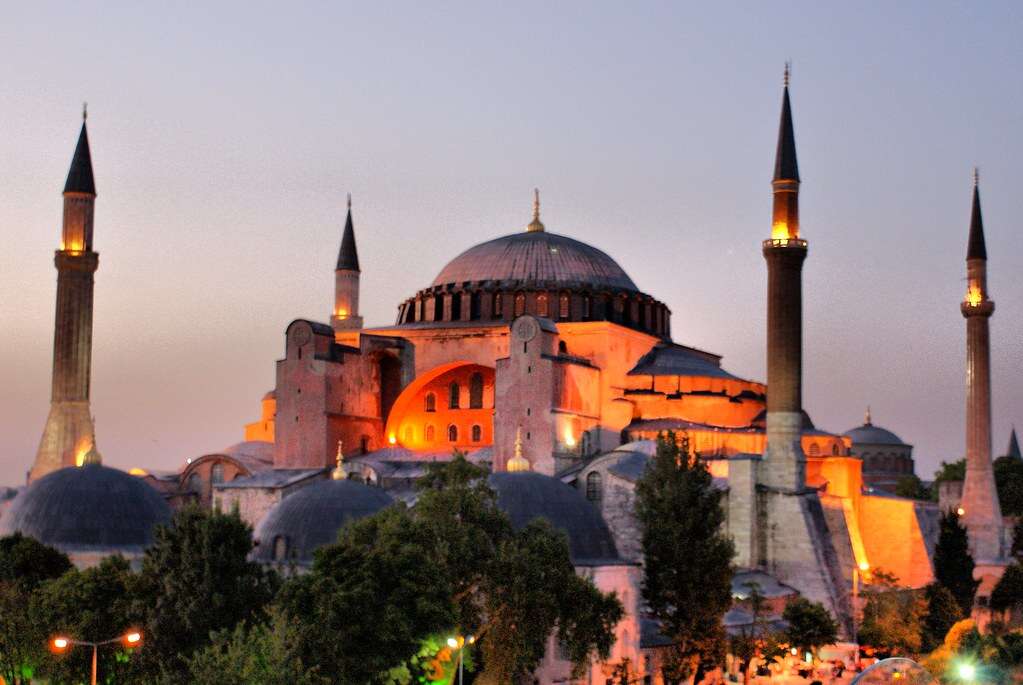

Turkey on Monday started the first-ever comprehensive restoration work on the main dome of Hagia Sophia, one of the most important historical sites in Istanbul.
Turkish Culture and Tourism Minister Mehmet Nuri Ersoy said on social media platform X that the dome will be reinforced to better withstand earthquakes without changing or damaging its original structure and decorations.
To ensure that worship and the restoration work continue simultaneously, a steel platform is being constructed on four 43.5-meter-high main columns supporting the dome, Ersoy said.
Tarihe sahip çıkıyoruz, Ayasofya’yı geleceğe taşıyoruz!
1486 yıllık Ayasofya-i Kebir Camii Şerifi’nde, ibadete ara vermeden restorasyon ve güçlendirme çalışmalarımızı sürdürüyoruz. Bu çalışmaların bir kısmını tamamladık, kalan bölümleri ise dikkatle yürütüyoruz.
Bu süreçte,… pic.twitter.com/YIcwaN2eW6
— Mehmet Nuri Ersoy (@MehmetNuriErsoy) April 14, 2025
The main dome, measuring some 31 meters in diameter and 56 meters in height, is renowned for its grandeur and ingenious design.
“We have been carrying out intensive restoration efforts on Hagia Sophia and its surrounding structures for three years,” said Mehmet Selim Okten, a construction engineer, lecturer at Mimar Sinan Fine Arts University and a member of the scientific council overseeing the renovations.
“At the end of these three years, we have focused on the seismic safety of Hagia Sophia, the minarets, the main dome and the main arches, especially due to the expected Istanbul earthquake.”
In 2023, a 7.8 magnitude earthquake struck southern Turkey, destroying or damaging hundreds of thousands of buildings and leaving more than 53,000 people dead. While Istanbul was not impacted, the devastation in southern Turkiye heightened fears of a similar quake with experts citing the city’s proximity to fault lines.
Ahmet Gulec, a member of the project’s scientific committee, said damage to the dome’s lead cover and cement materials made the restoration necessary. “The underside of the dome is covered in mosaics, making structural intervention from below nearly impossible,” Gulec explained.
This restoration is part of a larger 50-year project, which was initiated in 2023 by the Turkish Culture and Tourism Ministry to “eliminate the centuries-old fatigue” of the 1,500-year-old Hagia Sophia.
Turkey is beginning a major restoration project on the dome of Istanbul’s 1,486-year-old Hagia Sophia, focusing on reinforcing weak points identified through earthquake simulations https://t.co/5RBIyxYIdv pic.twitter.com/JOfVTSnAEo
— Reuters (@Reuters) April 15, 2025
Hagia Sophia, meaning “Holy Wisdom” in Greek (Αγία Σοφία), was built in 537 A.D. under the rule of Byzantine Emperor Justinian I. For nearly 900 years, it stood as the most significant cathedral of Eastern Orthodox Christianity and a crowning achievement of Byzantine architecture. Its grand dome and intricate mosaics symbolized the rich artistic and engineering skills of the Greek-speaking Byzantine world.
Following the Ottoman conquest of Constantinople in 1453, Hagia Sophia was converted into a mosque. Christian mosaics were covered and Minarets and Islamic elements were added, marking a new chapter in the building’s long history.
In 1935, it was turned into a museum under the Turkish Republic. In 2020, it returned to its former status as a mosque, but it remains open to visitors from all over the world.
Enlisted as a UNESCO World Heritage Site in 1985, Hagia Sophia is one of the most popular tourist spots in Türkiye.
